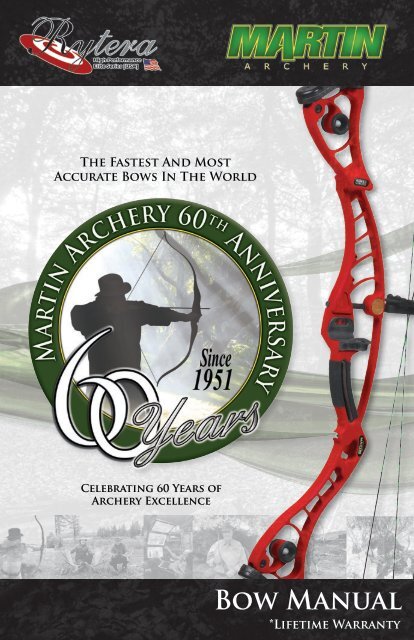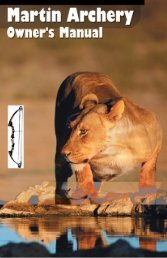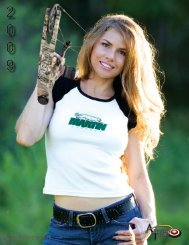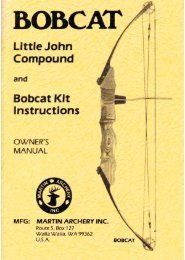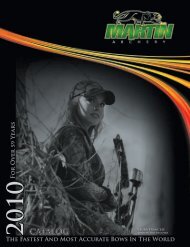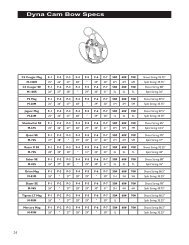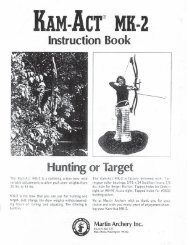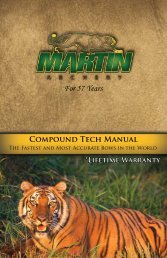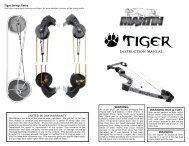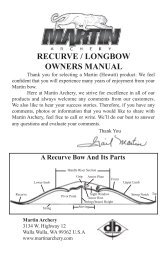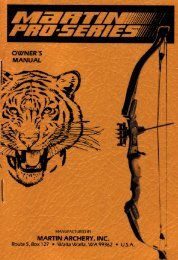Bow Manual - Martin Archery
Bow Manual - Martin Archery
Bow Manual - Martin Archery
You also want an ePaper? Increase the reach of your titles
YUMPU automatically turns print PDFs into web optimized ePapers that Google loves.
The Fastest And Most<br />
Accurate <strong>Bow</strong>s In The World<br />
Celebrating 60 Years of<br />
<strong>Archery</strong> Excellence<br />
<strong>Bow</strong> <strong>Manual</strong><br />
*Lifetime Warranty
Owner's Record<br />
Welcome to the <strong>Martin</strong> <strong>Archery</strong> Family. We are confident that you will experience many<br />
years of enjoyment from your new <strong>Martin</strong> bow. Each bow that leaves our door is handmade<br />
one at a time as they have been for over 60 years. <strong>Martin</strong> <strong>Archery</strong> remains a family owned<br />
and operated business. We take great pride in every product we produce and we strive to<br />
offer you the most complete line of professional accessories available.<br />
We welcome any comments you may have about our products. We also like to hear<br />
stories of your successes while using our products. If you have any comments, photos, or<br />
information you would like to share with us, please call or write. We will do our best to answer<br />
any questions you may have.<br />
To better serve you, we have the most complete archery manufacturer's web page on the<br />
World Wide Web. Our web page is located at: www.martinarchery.com<br />
2<br />
<strong>Bow</strong> Model: _____________________________<br />
Date Purchased: _____________________________<br />
Cam Style: _____________________________<br />
Draw Weight: _____________________________<br />
Draw Length: _____________________________<br />
String Length: _____________________________<br />
Cable Length: _____________________________<br />
Purchased From: _____________________________<br />
NOTICE:<br />
Staple your sales receipt here<br />
Proof of purchase date is needed<br />
should you ever require warranty work<br />
Thank You,<br />
Gail <strong>Martin</strong><br />
Founder and President
Table Of Contents<br />
Parts Of The <strong>Bow</strong>.....................................................................4<br />
Basic Setup<br />
• Cable Guard And Arrow Alignment .......................................................5<br />
• Setting Center Shot ...............................................................................5,13<br />
• Quick Arrow Rest And Nock Placement ................................................6<br />
• Setting Tiller ...........................................................................................6<br />
• Measuring Draw Length ........................................................................6<br />
• Setting Nock Point With A <strong>Bow</strong> Square ................................................7<br />
• Changing Draw Weight .........................................................................7<br />
• Replacing the Strings ............................................................................7<br />
• Care and Storage ..................................................................................7<br />
• Installing and Adjusting the Draw Stop ..................................................8<br />
• Installing and Adjusting the STS ...........................................................8<br />
• Adjusting the STS .................................................................................8<br />
Cam Systems<br />
Single Cam Systems that Use F Modules<br />
• Parts of the Single Cam System ...........................................................9<br />
• Adjusting The Single Cam Draw Length ...............................................9<br />
• Single Cam String Diagram ...................................................................9<br />
Hybrid Duo Cams Systems<br />
• Parts of the Hybrid Duel Cams ..............................................................10<br />
• Changing the Hybrid Duel Cams Draw Length .....................................10<br />
• Hybrid Duel Cams String Diagram ........................................................10<br />
• Hybrid Duo Cams Rotation ...................................................................11<br />
• Tuning Duel Cams ...............................................................................12<br />
Fine Tuning Your Compound <strong>Bow</strong><br />
• Setting Center Shot ............................................................................... 5, 13<br />
• Paper Tuning ......................................................................................... 13-15<br />
• Bare Shaft Planing Test ........................................................................ 16-17<br />
• Super Fine Quick Tune ......................................................................... 18<br />
• Flight Tuning Broadheads ..................................................................... 19<br />
<strong>Archery</strong> Safety ............................................................................ 15<br />
Seeker 365 Grip Adjustment ..................................... 20<br />
Warranty .......................................................................................... 21<br />
3
Parts Of The <strong>Bow</strong><br />
4<br />
Upper Limb<br />
Limb Bolt<br />
Vibration<br />
Escape<br />
Module<br />
Riser<br />
Rest Mount<br />
Stabilizer<br />
Mount<br />
Roto Cup<br />
Lower Limb<br />
Grip<br />
Axle<br />
Cables<br />
Barrel Nut<br />
Quiver Mounts<br />
Shooting String<br />
Cam<br />
Model Shown: Firecat 400 with Nitro 2.0 Cams<br />
Information in this manual pertains to all <strong>Martin</strong> <strong>Bow</strong> Models.<br />
Cam<br />
(Idler wheel on Single Cam Systems)<br />
SOS<br />
String Oscillation Suppressor<br />
TRG<br />
(Torque Reducing Guard)
Basic Setup<br />
Your new <strong>Martin</strong> bow takes little setup to get started shooting. Please read and<br />
familiarize yourself with these starting procedures before shooting. Many of these<br />
procedures may have been completed by your authorized <strong>Martin</strong> dealer. After<br />
completing these simple steps, you will be more accurate and will have greater success<br />
from the start. A careful and thorough initial setup will make the tuning process much easier.<br />
Cable Guard<br />
The Cable guard should be positioned for adequate<br />
fletching clearance. Depending on model, your bow may have<br />
a strait carbon cable guard installed. If so, your cable guard is<br />
already positioned for optimum fletching clearance, and no further<br />
adjustment is needed. If your bow came with a metal, dog legged<br />
cable guard, please follow the directions below. Caution should be<br />
taken against over rotating the cable rod as excessive clearance<br />
can cause unnecessary pressures on the limbs and axle bearings.<br />
Follow these steps:<br />
1. Visually align shooting string down the center of the grip for single<br />
cam, and outside center for duo cams (3/16" to the left of center on<br />
right hand bows, 3/16" to the right on left hand bows).<br />
2. Adjust arrow rest left or right so arrow is centered with the<br />
shooting string.<br />
3. Adjust cable guard so that cables are off-set no more than needed<br />
for fletching clearance.<br />
Once optimum angle is achieved, fully tighten the screw, but do<br />
not over tighten.<br />
Setting Center Shot<br />
After your arrow rest is installed, you will<br />
need to set it at a good starting point to<br />
begin tuning. The easiest way to do this is to<br />
visually align the bowstring in the center of<br />
the grip section. If you are shooting your bow<br />
with a release aid, your rest will need to be<br />
centered with the bow string. During tuning, your<br />
arrow rest may need to be moved in or out<br />
from its centered location. This is normal<br />
because different shooters apply different<br />
pressures to the bow. Finger shooters will<br />
need to position the rest so that the point<br />
is about 1/8” outside the string. This is to<br />
compensate for the horizontal bending of<br />
the arrow upon release. An arrow rest that<br />
provides some side support, such as a<br />
cushion button for the arrow, is best for finger<br />
shooters.<br />
Finger<br />
Setting<br />
2 3<br />
1<br />
Release<br />
Setting<br />
5
Basic Setup<br />
Quick Arrow Rest and Nock Placement<br />
You can quickly and easily set the position of your rest<br />
and nock point using the rest mount holes in your bow. Your<br />
rest should sit level with the two rest mount holes, or lock<br />
mount of your bow. (See graphic) When the rest placement<br />
is correct, you can begin placing the nock set. Place a nock<br />
loosely on the string and nock an arrow. Visually align the<br />
arrow level with or slightly tail high of the rest mount holes.<br />
When the correct height is set, crimp the nock set into place.<br />
This will give you a good starting point to begin tuning your bow.<br />
Setting The Tiller<br />
Taking a tiller measurement allows you to check the relative<br />
tension setting of the upper and lower limbs. After setting the draw<br />
weight on your bow, you will need to check the tiller measurement<br />
to make sure that you have adjusted your limbs evenly. On all <strong>Martin</strong><br />
compound bows, “0” or even tiller will shoot perfectly. However, the tiller<br />
measurement can vary up to 1/4” closer at the bottom. There is<br />
no set measurement that provides peak performance for every<br />
shooter. To measure your tiller, simply measure from the limb pockets<br />
to the string on both ends of the bow. Some shooters find that different<br />
tiller measurements from "0" work better for them. It will not hurt your<br />
bow in any way if you experiment with tiller.<br />
Note: Your Peep Sight position and your nock point position can<br />
change when you turn one limb bolt. Take detailed measurements<br />
and be sure that your nock and peep are correct each time you<br />
turn your limb bolts.<br />
Measuring Draw Length<br />
When your bow is at full draw, the apex of the string should be<br />
near the corner of your mouth.<br />
Draw length can easily be measured from the apex of the string at full<br />
draw to the pivot point of the grip. From<br />
that measurement add 1 ¾” and you will<br />
have the A.M.O. standard draw length.<br />
All <strong>Martin</strong> <strong>Bow</strong>s are adjustable with the<br />
use of modules. Refer to the section that<br />
covers your specific cam style for instructions<br />
on adjusting draw length.<br />
6
Basic Setup<br />
Setting Nock Point With <strong>Bow</strong> Square<br />
Place a bow square on the string and slide the square down until<br />
it rests on your arrow rest. Then place a moveable nock set on the<br />
string. Using the measuring scale on the bow square, set the nock<br />
set at the proper location on the string. A good starting point for<br />
finger shooting is ¼” high, measuring from the bottom of the nock<br />
set to 90° on the bow string. Start at 1/8” high if you are using a<br />
release aid. If you do not have a bow square, you can snap an<br />
arrow on the string and visually level the arrow. Then crimp your<br />
nock set. In a pinch, this will get you to a good starting location.<br />
1/2<br />
1/4<br />
90 0<br />
Arrow Speed and String Accessories<br />
Certain bowstring accessories including D-loops, string silencers, and peep sights, can<br />
reduce arrow speed by as much 10-15 fps.<br />
Changing Draw Weight<br />
<strong>Martin</strong> bows have a fifteen pound draw weight range. Using a 3/16” allen wrench ; you will<br />
turn the limb bolts clockwise to add weight and turn counter clockwise to reduce weight. One<br />
complete turn on each limb bolt provides about 3 pounds of adjustment.<br />
TIP: Mark a line on each limb bolt in white-out or white paint marker to make it easier to<br />
keep track of how far you are turning each bolt.<br />
Note: Do not shoot your bow with the limb bolts more than 5 turns out from the<br />
riser.<br />
Replacing The Strings<br />
Should your string need replacing, it is best to go to your <strong>Martin</strong> dealer and have it done<br />
by experts. Always be sure that the string you replace it with is of the correct length and<br />
material for your bow. We recommend using <strong>Martin</strong> Hammerhead bow strings. String wear<br />
is not covered by warranty.<br />
Care And Storage<br />
When properly cared for, your new <strong>Martin</strong> bow will give you years of trouble-free service.<br />
When your bow is new it will require no lubrication. Over time you may need to lubricate your<br />
cams to guard against friction and noise. Use a dry lubrication such as Teflon spray powder<br />
or graphite powder. You can also use wet lube such as Moly Lube or Tri-Flow. Do not use<br />
WD-40 lubrication.<br />
A good rule of thumb when caring for your bow is to keep it as comfortable as you are. If<br />
it is too hot for you, it is too hot for your bow. If it gets wet, dry it off completely. Periodically<br />
clean your bow with a wet rag and mild soap to remove mud or dust (caution: do not store<br />
until completely dry). Prolonged exposure to extreme heat may cause failure in your bow<br />
limbs and excessive stretch in your string system. It will not hurt your bow if it is rained on<br />
while shooting, but make sure it is completely dry before storing it in a bow case to guard<br />
against rust or corrosion.<br />
7
Basic Setup<br />
Installing and Adjusting the Draw Stop.<br />
There are a total of four parts to the Draw Stop<br />
assembly. A rubber cap, the aluminum body of the Draw<br />
Stop, an 8/32 screw and an 8/32 hex nut.To install the stop,<br />
place the hex nut in the track on the back side of the cam.<br />
To adjust the stop, draw the bow back either by hand or in a<br />
scale/shooting machine. At full draw, slide the stop until it<br />
contacts the under side of the limb. Back the<br />
stop off of the limb 1/32” (appox.) to allow for the<br />
rubber cap to be installed. Snug down the Draw Stop<br />
with the appropriate Hex head wrench, and install the<br />
rubber cap over the Draw Stop.<br />
Note: Some versions of the Acu-Trak and C.A.T. cams have numbered draw<br />
stop tracks which have no correlation to the draw module number or draw module<br />
position numbers.<br />
Installing and Adjusting the STS<br />
Most <strong>Martin</strong> bows are outfitted with an STS String Dampening unit, or are equipped to<br />
accept one. This unit is installed in the 3/8” diameter hole located just below the grip and<br />
is secured in place with the set screw intersecting this hole from the side of the riser. The<br />
STS rod should be positioned so that the STS Bumper is nearly against the bowstring when<br />
the bow is at rest. Excessive contact with the bowstring will prevent the STS Bumper from<br />
performing effectively as a dampener, and may cause the Bumper to be pulled off by the<br />
bowstring during the shot. A small gap (approximately 1/16”) should be allowed between the<br />
bowstring and Bumper when the bow is at rest.<br />
Adjusting the TRG<br />
To function properly, the cables running thru the TRG<br />
should travel freely all the way to full draw without<br />
long-term contact with the end of the cable slot. With<br />
some longer draw lengths, the cable may reach the<br />
end of the slot before the archer reaches full draw,<br />
allowing the cable to rub against the end of the slot.<br />
When this occurs, a small adjustment can be made to<br />
extend the TRG rod out from the riser. First, pull the<br />
cables off of the TRG and around to the sight window<br />
side of the unit. Next, loosen the two Allen screws<br />
securing the rod to the riser and slide the rod<br />
outward. A very small adjustment is all that is required.<br />
(Both screws should remain in full contact with the rod<br />
when re-secured.) Tighten the screws and reinstall the<br />
cables to their slots on the TRG.<br />
8<br />
Draw Stop<br />
In Place<br />
Correct cable placement<br />
with bow at rest.<br />
Cables too far towards the back of<br />
the TRG with the bow at rest for<br />
some longer draws.
Single Cams That Use F Modules<br />
<strong>Martin</strong> Single Cam systems feature a modular draw length adjustment. A series of draw<br />
length modules are used to adjust draw length in one-inch increments (see below). Draw<br />
lengths can also be adjusted in half-inch increments within each size module.<br />
Parts Of The Single Cam Systems<br />
Module<br />
Screws<br />
Module<br />
Draw<br />
Stop<br />
Speed Bearing<br />
Bottom Cam<br />
Idler Wheel<br />
Adjusting The Single Cam Draw Length<br />
Using draw length modules, the draw length can be adjusted in 1" increments. To change<br />
the draw length, replace the module on the cam by removing the screws that hold it to the<br />
cam. NOTE: do not draw your bow without the module installed. It will damage your<br />
harness.<br />
The module sizes range from F-1 to F-7. As the module numbers get higher, the draw gets longer.<br />
The draw length can also be adjusted in 1/2" incrementsusing the pegs on the back of the cam.<br />
This method of draw adjustment applies to ALL <strong>Martin</strong> Single Cam System (Acu-Trak,<br />
Fuzion, Dyna, M-Pro, and M2).<br />
Single Cam String Diagram<br />
The string harness on your Single Cam is installed according to the diagram below. Your<br />
string harness should be installed by your qualified <strong>Martin</strong> dealer.<br />
Split<br />
String<br />
Return Cable Peg<br />
2nd half<br />
Shooting<br />
String<br />
Shooting<br />
String<br />
Speed Bearing<br />
9
Hybrid Duo Cams Systems<br />
Your Hybrid Duo Cams (Nitro, Hybrix, C.A.T, etc.) are each equipped with a rotating<br />
draw length module. Each draw length module has numbers that indicate draw length settings.<br />
The Standard Module has positions that number #1 through #7, with each number<br />
providing ½” additional draw length. The Long Module has positions #8 and #9. The higher<br />
the # position, the longer the draw length.<br />
Parts of Hybrid Duo Cams<br />
Changing the Hybrid Cams Draw Length<br />
When you are adjusting the draw length, make sure<br />
that both the upper and lower modules are in the same<br />
setting. To rotate the modules, you will first need to<br />
remove the two (2) allen head module screws. Rotate<br />
the module to the desired position and replace and<br />
tighten the screws in the appropriate positions.<br />
DO NOT attempt to draw the bow without the<br />
draw length modules in place and secured.<br />
Hybrid Duo Cams String Diagram<br />
10<br />
Module Screws<br />
Module<br />
Draw<br />
Stop<br />
Speed Bearing<br />
Shooting<br />
String Anchor<br />
Module Screws
Hybrid Duo Cams Systems<br />
Hybrid Duo Cams Rotation<br />
Notice where<br />
the cables<br />
cross over<br />
the #5 hole<br />
mod screw.<br />
11
Tuning Duel Cams<br />
Cam tuning assures straight and level<br />
travel of the arrow (nock travel) as it<br />
travels thru and from the bow. Tuned<br />
Cams will benefit accuracy and keep<br />
noise and vibration to a minimum. To<br />
determine if any tuning is necessary, first<br />
draw your bow using your release aid<br />
(if you use one when shooting), and an<br />
arrow to prevent dry fire. As you approach<br />
full draw, slow down and watch as the<br />
cable stops (the ends of each draw<br />
length module) move toward each cable,<br />
as shown in the diagram. It is helpful to<br />
ask a friend to examine this for you while<br />
you draw the bow. Each cable should<br />
contact the end of each cam’s draw length<br />
module at the same time. If your cams<br />
look like those on the left side of the<br />
diagram, they are properly tuned. If one<br />
cable touches before the other, as seen<br />
on the right side of the diagram, some<br />
tuning is required.<br />
First, relax the bow properly in a<br />
bowpress before attempting to make any<br />
adjustments.<br />
12<br />
Nitro & Hybrix Cam<br />
Both cable<br />
stops are<br />
touching in<br />
unison. It is<br />
perfect.<br />
Furious<br />
Both cable<br />
stops are<br />
touching in<br />
unison. It is<br />
perfect.<br />
The top cable stop<br />
is coming to rest<br />
before the bottom.<br />
Add a twist in the<br />
cable that feeds<br />
into the top module.<br />
The top cable<br />
stop is coming to<br />
rest before the<br />
bottom. Add a<br />
twist in the cable<br />
that is connected<br />
to the top cam.<br />
Correct Tuning Needs Adjusted<br />
Correct Tuning Needs Adjusted
Fine Tuning Your Compound <strong>Bow</strong><br />
•Setting Center Shoot<br />
Nock an arrow on your bow and stand directly behind your bow holding<br />
it in your bow hand. Look down the back of your bows riser and grip and<br />
turn the bow until the string is centered down the middle of your riser and<br />
grip. Adjust your rest left or right to make your arrow perfectly centered on<br />
your string. See page 5 for more details.<br />
•Paper Tuning<br />
Paper tuning will work for all styles of shooting. As you are going through<br />
these steps keep in mind that paper tuning is not chiseled in stone as the law of archery. It is a<br />
guideline for clean arrow flight. Many shooters find that their setup shoots most accurately<br />
when achieving less than perfect tuning results. For example, some target shooters set their<br />
bows to tear slightly high through the paper. They feel this makes their arrow flight less likely<br />
to be influenced by outside variables like wind or rain and helps arrow clearance when using<br />
a shoot-around type rest such as a blade or pan type launcher.<br />
To begin paper tuning, set up a frame or rack with paper suspended from the<br />
frame. Position the frame far enough away from your backstop so the arrow can<br />
completely clear the paper. Stand about ten feet from the paper and make sure<br />
your arrow is level as it flies through the paper. Fire a test shot and read the results.<br />
Compare the holes you have made in the paper to the diagrams below.<br />
Procedures for correcting the tear are listed next to each diagram. Please note that tuning<br />
procedures recommended for finger shooting often differ from those used for<br />
release shooting. You will find that the arrow spine reaction is different for fingers<br />
and release, therefore, the procedures for correcting the different disturbances vary.<br />
Follow the instructions carefully for your particular shooting style.<br />
High Tear (fletching tears above point)<br />
This tear may signal:<br />
•Nocking point too high: Lower the nocking point.<br />
•Improper vane clearance: See if arrow fletching is hitting the rest.<br />
•Launcher is too stiff (release shooters): Weaken spring tension or<br />
use a more limber launcher.<br />
•Wheels may be out of time: Check wheel timing.<br />
•Arrow may be too limber: Select a stiffer arrow shaft.<br />
•Tiller adjustment may be incorrect: See basic setup section page 6.<br />
•Irregular or inconsistent shooting form: See a qualified archery coach<br />
or professional and have them check your technique.<br />
Low Tear (fletching tears below point)<br />
This tear may signal:<br />
•Nocking point too low: Raise the nocking point.<br />
•Wheels may be out of time: Check wheel timing.<br />
•Tiller adjustment may be incorrect: See basic setup section on page 6.<br />
•Irregular or inconsistent shooting form: See a qualified archery<br />
coach or professional and have them check your technique.<br />
13
Fine Tuning Your Compound <strong>Bow</strong><br />
•Paper Tuning -Continued<br />
Right Tear (fletching tears to the right of point)<br />
This tear may signal:<br />
Note: If you are left handed follow these instructions in reverse.<br />
Fingers:<br />
•Stiff arrow.<br />
This problem is cured using one or more of the following methods:<br />
a. Increase peak weight.<br />
b. Use a heavier point.<br />
c. Select a more limber arrow.<br />
d. Lighten cushion plunger tension, or use a weaker spring on shoot around rests.<br />
e. Make small incremental rest adjustments towards the bow.<br />
Release:<br />
•Arrow rest is too far to the right: Move arrow rest to the left.<br />
Either Style:<br />
•Too much pressure on the cable guard: Rotate cable guard for minimum<br />
fletching clearance.<br />
•Irregular or inconsistent sho oting form: See a qualified archery coach or<br />
professional and have them check your technique.<br />
•Clearance problem: See that arrow has adequate fletching clearance.<br />
Left Tear (fletching tears left of point)<br />
This tear may signal:<br />
Note: If you are left handed follow these instructions in reverse.<br />
Fingers:<br />
•Weak arrow or a clearance problem.<br />
This problem is cured using these methods:<br />
a. Reduce bow weight.<br />
b. Use a lighter point.<br />
c. Select a stiffer arrow.<br />
d. Increase cushion plunger tension or use a stiffer spring on shoot around rests.<br />
e. Make small incremental rest adjustments away from the bow .<br />
Release:<br />
•Arrow rest is too far to the left: Move the arrow rest to the right.<br />
•Arrow is too weak: Decrease bow weight or select a stiffer arrow.<br />
Either Style:<br />
•Arrow is not properly clearing cables: Rotate cable guard for complete<br />
fletching clearance.<br />
•Irregular or inconsistent shooting form: See a qualified archery coach<br />
or professional and have them check your technique.<br />
•Arrow rest clearance problem: See that arrow has adequate fletching<br />
clearance through or over the arrow rest.<br />
14
Fine Tuning Your Compound <strong>Bow</strong><br />
•Paper Tuning -Continued<br />
Multidirectional Tear<br />
This tear may signal:<br />
•More than one problem with accessory adjustment.: Move nock<br />
adjustment first until the tear is horizontal and follow instructions for<br />
horizontal tear.<br />
•Clearance Problem: See that the arrow has adequate fletching clearance.<br />
•Wheels may be out of time: Check wheel timing.<br />
•Irregular or inconsistent shooting form: See a qualified archery coach<br />
or professional and have them check your technique.<br />
Perfect Hole<br />
This pattern shows clean arrow flight. The point and fletching<br />
impacted the same location. Your bow is now ready to shoot or you may want<br />
to continue and try some of the super fine tuning methods.<br />
After Adjusting<br />
After you have completed these steps and have achieved good paper test<br />
results, it is best to try it at fifteen and twenty feet just to make sure you did not get a false<br />
reading. A good rule to go by when paper tuning is to move your nock point or arrow rest<br />
opposite the tear when using a release. In some rare cases if this does not clear up your tear<br />
you may need to move your accessories in the same direction as the tear.<br />
Ten Commandments Of <strong>Archery</strong> Safety<br />
Never - “Dry fire" your bow (shoot it without an arrow.) This will result in damage to your bow and/<br />
or possible injury.<br />
Never - Let anyone draw or shoot your bow if their draw length is longer than yours. Over drawing<br />
of the bow can cause cable damage.<br />
Never - Draw, aim, or shoot your bow unless you are sure that the line of fire is clear. Remember,<br />
once an arrow is fired it cannot be recalled.<br />
Never - Shoot an arrow that is less than five grains per pound. For example, an 80# bow requires a<br />
minimum of 400 grains of arrow weight. Less than five grains per pound of arrow weight<br />
simulates a dry fire effect and may damage your bow.<br />
Never - Expose your bow to extreme heat. Excessive heat, such as your car on a hot day, could<br />
lead to limb failure and premature wearing of the string harness.<br />
Always - Check all of your arrow shafts and nocks upon removal from the target. If the arrows show<br />
defects or broken nocks, do not shoot them.<br />
Always - Carefully inspect your bow after each use. Be sure all screws are snug and accessories<br />
are tight. Inspect your string and cables for wear or damage.<br />
Always - Draw your bow while pointing it at the target. A premature release of the arrow can be very<br />
dangerous. If you cannot draw your bow while pointing it at the target without excessive<br />
movement, lower the peak weight of your bow until you can draw smoothly and correctly.<br />
Over time you will build up strength, and will be able to return to the higher weight.<br />
Always - Draw your bow with an arrow on the string while keeping it pointed in a safe direction.<br />
Never draw your bow with a release aid without an arrow. A release aid failure could result<br />
in the dry fire of your bow.<br />
Always - Back your limb bolts off five full turns from the riser before putting it in a bow press. Only let<br />
a qualified professional or a <strong>Martin</strong> authorized dealer put your bow in a bow press.<br />
Inexperienced use of a bow press or a T-stringer can result in damage to your bow. The<br />
type of damage caused by a press is not covered under the <strong>Martin</strong> <strong>Archery</strong> bow warranty.<br />
15
Fine Tuning Your Compound <strong>Bow</strong><br />
•Bare Shaft Planing Test<br />
The Bare Shaft Planing method of tuning works best when using a finger release. To begin<br />
the Bare Shaft Planing test you will need three fletched arrows and one or two bare shafts.<br />
You will also need a target that will catch the arrows without allowing the arrow to kick as it<br />
stops in the target. This test will help you establish the correct nock and rest position, and<br />
it will tell you if your arrow is the correct spine. Porpoising and Fish Tailing describe the<br />
different flight disturbances you may encounter while tuning.<br />
Porpoising<br />
Porpoising is identified by an up and down kick during arrow flight and relates to the<br />
nock point adjustment. It is important to correct porpoising first because small left and right<br />
disturbances could be nock point related. Start at about ten to fifteen yards and shoot three<br />
fletched arrows into your target. Using the same aiming point, follow them up with a bare<br />
shaft. After you get the bare shafts to impact with the fletched shafts, you may want to try<br />
shooting them at a longer distance for a finer indication of arrow flight.<br />
16<br />
A high nock set will cause porpoising.<br />
If the bare shafts impact below the fletched arrows, your nock point is too high. Move<br />
your nocking point down in small increments until the bare shaft strikes with the fletched<br />
shafts. If the bare shafts impact above your fletched arrows, your nock point is too low. Raise<br />
your nock point in small increments until your fletched arrows and your bare shaft impact<br />
together.<br />
Repeat the above steps from a longer distance to make sure you have<br />
completely corrected the nock point. Shooting from a longer distance will make minor<br />
disturbances more apparent.<br />
High nocking point<br />
Low nocking point.
Fine Tuning Your Compound <strong>Bow</strong><br />
Fishtailing<br />
Fishtailing relates to the arrow rest adjustment and the stiffness of your<br />
arrow. Just as before, start at about ten to fifteen yards and shoot three fletched arrows into<br />
your target. Using the same aiming point, follow them up with a bare shaft. After you get<br />
the shafts to impact with the fletched shafts, you may want to try shooting them at a longer<br />
distance for a finer indication of arrow flight.<br />
If your unfletched shafts impact to the left of your fletched shafts, your arrow is too stiff.<br />
There are two things that you can do to correct this problem; you can select a weaker<br />
arrow, or you can decrease the cushion plunger tension. Increasing the peak weight of<br />
your bow or increasing your point weight will also make your arrow act a bit more limber.<br />
If your unfletched shafts impact to the right of your fletched shafts, your arrow is too limber.<br />
There are two methods you can try that will correct this problem; you can select a stiffer<br />
arrow, or you can increase the cushion plunger tension. Decreasing the peak weight of your<br />
bow or decreasing your point weight will also make your arrow act a bit more stiff.<br />
To further fine tune your setup, step back to twenty or thirty yards and repeat<br />
the above procedures. Small flight disturbances will show up better as you get<br />
farther from the target. Your <strong>Martin</strong> bow is essentially tuned when your bare shafts hit<br />
together with your fletched shafts. Keep in mind that if you continue and complete the super<br />
fine tuning methods in this manual, it is not uncommon for your bare shaft impact to change.<br />
Even with your bow shooting its best, it is common for a perfectly tuned bow to shoot a bare<br />
shaft a bit low and right or low and left. Perfect arrow groups are the goal when completing<br />
these exercises.<br />
Stiff Arrow.<br />
Bare shafts fly to left.<br />
Limber Arrow<br />
Bare shafts fly to right.<br />
Left handed shooters should follow instructions in reverse.<br />
17
Fine Tuning Your Compound <strong>Bow</strong><br />
•Super Fine Quick Tune<br />
Short range group tuning will work with any style of shooting. Best results are achieved<br />
when this method is used after completing the Bare Shaft Planing or Paper Tuning tests.<br />
This is a good ultra fine tuning method when space will not permit long range shooting. After<br />
completing the following steps you will have very clean arrow flight and a well tuned, accurate<br />
setup.<br />
To begin the short range tuning method, you will need a piece of cardboard, or a target<br />
face. Make a broad line through the center of the paper on the blank side, making sure the<br />
line is thick enough to see from twenty yards. Start at about 10 to 15 yards from the target.<br />
Use your tuning target and position the line vertically when you are tuning the arrow rest and<br />
position the line horizontally when you are tuning the nock point.<br />
Vertical Impact<br />
Position your line horizontally and shoot six arrows at the line.<br />
Concentrate on keeping your pin on the line. Don’t worry about<br />
left and right hits, just try to keep your shots on the line. Shoot two<br />
good groups, discarding any rough or bad shots, and note the<br />
vertical impact of the arrows and their relationship to the line. All<br />
adjustments are made with the nock point during these steps.<br />
If your arrows are not consistently grouping on the line, make<br />
small 1/32" adjustments up or down with the nock point and shoot<br />
two more groups. Continue making nock adjustments in small<br />
increments. If all of your arrows begin to hit on the line you are<br />
correcting the nock position. In the event that your groups widen,<br />
move your nock back to its original location and make small adjustments<br />
in the opposite direction.<br />
Horizontal Impact<br />
After achieving a nice, straight, horizontal pattern, rotate your target<br />
so your line will appearvertical.Just as before, shoot two good groups,<br />
discarding any rough or bad shots, and note the horizontal impact<br />
of the arrows and their relationship to the line. All adjustments are<br />
made with the arrow rest during these steps.<br />
If your arrows are not consistently grouping on the line, make<br />
small 1/32" adjustments left or right with the arrow rest and<br />
shoot two more groups. Continue making rest adjustments in<br />
small increments. If all of your arrows begin to hit on the line you<br />
are correcting the rest position. In the event that your groups<br />
widen move your rest back to its original location and make small<br />
adjustments in the opposite direction.<br />
Visit <strong>Archery</strong>talk.com for a video of this procedure.<br />
18<br />
This pattern shows a<br />
vertical disturbance.<br />
This pattern shows a<br />
clean vertical pattern.<br />
This pattern<br />
shows a<br />
horizontal<br />
disturbance.<br />
This pattern<br />
shows a clean<br />
horizontal<br />
pattern.
Fine Tuning Your Compound <strong>Bow</strong><br />
•Flight Tuning Broadheads<br />
Broadhead tuning will work for all styles of shooting. After you have completed one or<br />
more of the tuning procedures described in this manual, you can proceed with this final test<br />
to get your new bow ready to hunt. You will need three fletched arrows with field tips and<br />
three with broadheads that weigh the same as your field tips.<br />
Before you begin shooting, you will need to check your broadhead equipped<br />
arrows. After installing your broadheads, make sure they are perfectly straight on the shaft.<br />
This can be done by spinning the arrow on a flat counter while checking for any broadhead<br />
wobble. You can also use a commercially made spin check tool that is available from your<br />
dealer. After all of your broadheads are spin-checked and straight you are ready to begin.<br />
Set up a broadhead target at twenty or thirty yards and shoot three arrows with field tips.<br />
Make sure you are properly warmed up and you are shooting to the best of your ability.<br />
Next, shoot three identically aimed arrows with broadheads. WARNING: NEVER SHOOT<br />
BARE SHAFTS WITH BROADHEADS ATTACHED. THE FLIGHT WILL BE EXTREMELY<br />
UNPREDICTABLE AND DANGEROUS. Once you have shot the best group you can shoot,<br />
compare the position of the broadhead group to the field tip group. Compare the groups<br />
to the diagram below and make very small incremental adjustments as described next to<br />
the broadhead group that corresponds to your arrow pattern. Note: make very small 1/32"<br />
adjustments. A small adjustment will greatly change your broadhead flight.<br />
•Multidirectional Flight<br />
Correct the nock point first.<br />
Once the arrow is straight left,<br />
follow instructions for left flight.<br />
•Left Flight<br />
Release:<br />
Move arrow rest to<br />
the right in small<br />
increments.<br />
Fingers:<br />
•Slightly increase<br />
draw weight.<br />
•Use a heavier<br />
broadhead.<br />
•Decrease cushion<br />
plunger tension.<br />
•Move plunger toward the<br />
bow in small increments.<br />
Reverse steps for left hand shooter.<br />
•High Flight<br />
Raise nock point<br />
•Low Flight<br />
Lower nock point<br />
Field Point Group<br />
Broadhead Group<br />
•Right Flight<br />
Release:<br />
Move arrow rest<br />
to the left in<br />
small increments.<br />
Fingers:<br />
• decrease<br />
draw weight.<br />
•Use a lighter<br />
broadhead.<br />
•Increase cushion<br />
plunger tension.<br />
•Move plunger away<br />
from the bow in small increments.<br />
Reverse steps for left hand shooter.<br />
19
Seeker 365's Grip Adjustment<br />
3)<br />
20<br />
2)<br />
1)<br />
Re-tighten grip clamps<br />
so they are snug to<br />
eliminate unwanted<br />
movement.<br />
Adjusting the Seeker STS<br />
1) To Adjust the Seeker STS,<br />
2)<br />
loosen both set screws.<br />
Adjusting Seeker Grip<br />
Loosen both grip clamps to adjust brace height.<br />
Slide grip<br />
forward<br />
to desired<br />
position.<br />
You can now rotate the<br />
STS to adjust offset, and<br />
move it in and out to the<br />
desired position.<br />
Once the desired position<br />
is found, re-tighten both<br />
set screws so that they<br />
are snug.<br />
The upper and<br />
lower clamp<br />
can be<br />
adjusted<br />
separately<br />
to achieve<br />
desired grip<br />
angle.<br />
Brace Height Adjustment Specifications:<br />
5.75” brace height - Draw Length from 27” to 30”<br />
6.75” brace height - Draw Length from 28” to 31”<br />
7.75” brace height - Draw Length from 29” to 32”<br />
•To measure brace height, measure from the back of the grip to the shooting sting.<br />
•To square grip, measure from the back of the upper and lower grip clamps to the shooting string.
Warranty<br />
<strong>Martin</strong> Compound <strong>Bow</strong> Warranty<br />
LIMITED LIFETIME WARRANTY<br />
All <strong>Martin</strong> Compound <strong>Bow</strong>s are warranted against defects in materials or workmanship TO THE<br />
ORIGINAL OWNER, on all risers, limbs, limb pockets, axles, bearings, and cams (everything except the<br />
string and cables) for the life of the product*. (Strings and cables are not included, and should be<br />
changed either every season, or anytime they show wear, whichever comes first.) Does not apply<br />
to the Adventure Series.<br />
(*The life of a bow is determined according to the production cycle of the model and on-hand<br />
supply of replacement components. Should a bow no longer be in production and supply of<br />
components be exhausted, an upgrade fee may be charged in order to supply the customer with<br />
a newer, updated model. Cosmetic finishes or camouflage patterns on replacement parts, warranty or<br />
otherwise, are limited to availability.)<br />
The warranty is conditioned upon proof of purchase and other requirements listed below. IT<br />
IS IMPORTANT THAT YOUR SALES RECEIPT BE FILED IN A SAFE PLACE FOR FUTURE<br />
REFERENCE, AS REPAIRS WILL NOT BE PERFORMED UNDER WARRANTY WITHOUT A COPY OF<br />
THE DATED SALES RECEIPT. <strong>Martin</strong> <strong>Archery</strong>, Inc. warrants that your <strong>Martin</strong> compound bow will perform<br />
its intended function if used in accordance with the instructions provided. This Lifetime Warranty covers only<br />
the replacement parts, labor, and return ground transportation costs performed by <strong>Martin</strong> <strong>Archery</strong> Inc. to the<br />
customer. Transportation for the return of the bow to <strong>Martin</strong> <strong>Archery</strong>, Inc. is not covered. No C.O.D.<br />
shipments will be accepted by <strong>Martin</strong> <strong>Archery</strong>, Inc. Warranty repairs can be performed by an Authorized<br />
<strong>Martin</strong> Dealer, for which <strong>Martin</strong> <strong>Archery</strong>, Inc. will cover replacement parts and ground transportation costs to<br />
the Authorized Dealer. Labor costs for warranty repairs performed by Authorized Dealers are not covered by<br />
<strong>Martin</strong> <strong>Archery</strong>, Inc. <strong>Martin</strong> <strong>Archery</strong> makes no other warranty either expressed or implied, whether of fitness<br />
or of marketability, except as stated above. Any such additional warranty is expressly disclaimed. No agent,<br />
employee, or representative of <strong>Martin</strong> <strong>Archery</strong> or its dealers has the authority to bind <strong>Martin</strong> <strong>Archery</strong> to any<br />
agreement not herein stated. Buyer agrees that the sole and exclusive remedies for breach on any warranty<br />
concerning <strong>Martin</strong> <strong>Archery</strong> <strong>Bow</strong>s shall be repair or replacement of defective parts. <strong>Martin</strong> <strong>Archery</strong> shall not<br />
be liable for injury or property other than the bow itself. <strong>Martin</strong> <strong>Archery</strong> reserves the right to replace defective<br />
parts according to availability with compatible replacement parts.<br />
Warranty limitations are as follows:<br />
1. If bow shows signs of misuse, alteration, or mishandling this warranty will be void. Use of arrows weighing<br />
less than five (5) grains per pound of draw weight is considered misuse and will void this warranty.<br />
2. Warranty applies to original components only and does not extend to cover aftermarket strings, cables<br />
or accessories.<br />
3. The use of any aftermarket products / accessories that alter the manufacturers specs or design will void<br />
the warranty.<br />
4. Claimant must be the original purchaser. This warranty is not transferable.<br />
5. This Warranty pertains only to <strong>Martin</strong>-made products and does not extend to cover non-<strong>Martin</strong> accessory<br />
items that may be purchased with the bow. Warranty requests for non-<strong>Martin</strong> items will need to be made<br />
to the proper manufacturer.<br />
6. All returns to <strong>Martin</strong> <strong>Archery</strong> Inc. must be pre authorized. Owner must contact <strong>Martin</strong> <strong>Archery</strong>, Inc.<br />
at (509) 529-2554 prior to shipping in order to obtain a Return Authorization number.<br />
7. All accessory items must be removed from the bow prior to shipping. <strong>Martin</strong> <strong>Archery</strong>, Inc. will not be<br />
responsible for damage or loss of any accessory item left on the bow.<br />
8. Warranty is not effective unless a copy of the dated sales receipt accompanies the bow.<br />
9. This warranty gives you specific legal rights. You may also have other rights which vary from state to state.<br />
* This policy is subject to change and/or cancellation at the discretion of <strong>Martin</strong> <strong>Archery</strong>, Inc.<br />
* After acquiring a Return Authorization number, send bow to:<br />
<strong>Martin</strong> <strong>Archery</strong>, Inc.<br />
3134 Heritage Rd.<br />
Walla Walla, WA 99362<br />
21


